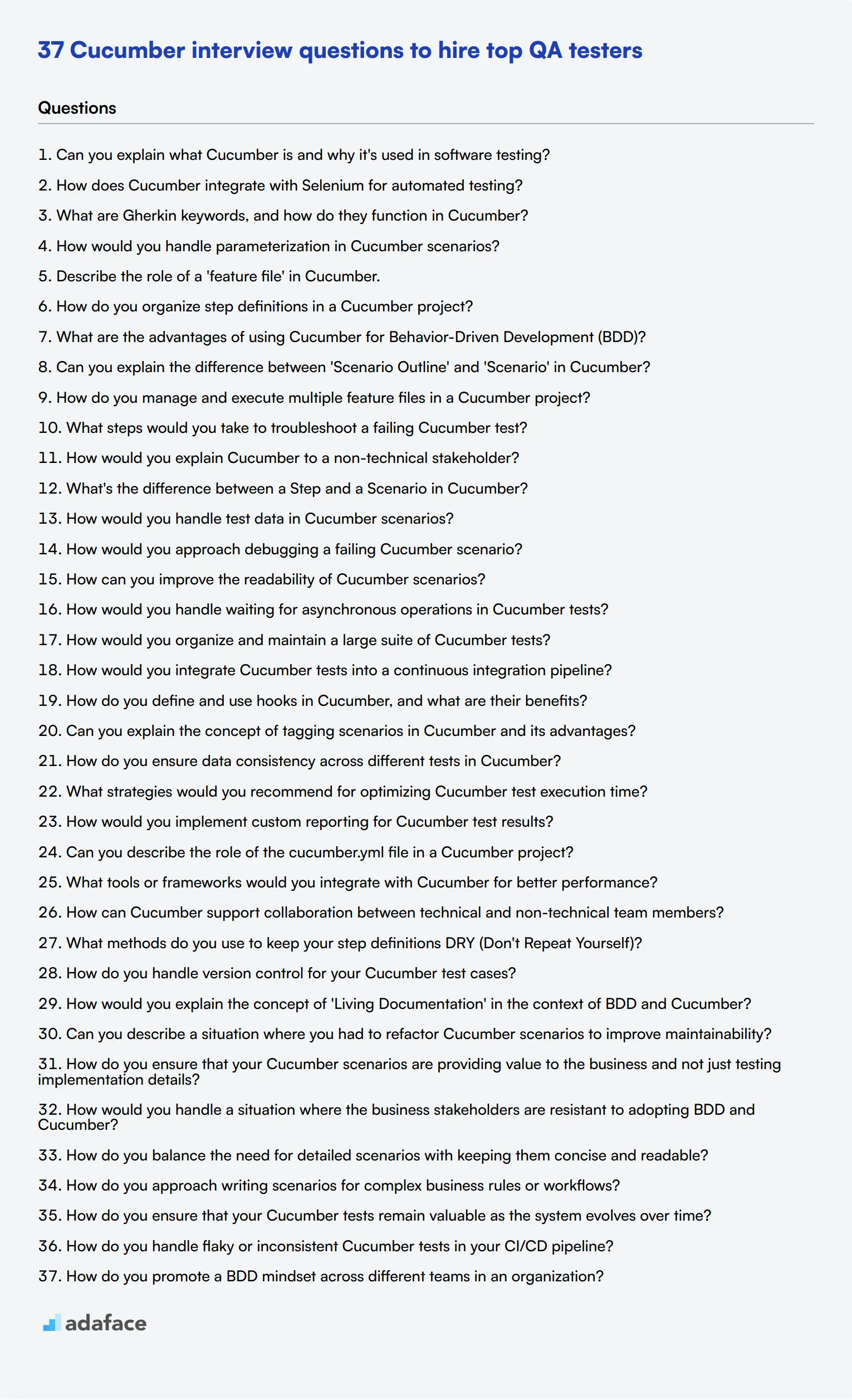Finding the right questions to assess potential hires for Cucumber testing is important for recruiting managers and hiring teams. A well-structured interview questioning strategy ensures you identify candidates who can effectively handle Cucumber and related automation tools.
In this blog post, we provide a comprehensive list of Cucumber interview questions, segmented into different categories for junior testers, automation processes, and BDD practices. These questions will help you gauge the expertise and practical skills of your candidates efficiently.
Using these questions, you can streamline your interview process and make informed hiring decisions. For more in-depth evaluation, complement your interviews with our Cucumber testing online test.
Table of contents
10 Cucumber interview questions to initiate the interview

To determine whether your applicants have the right skills and understanding of Cucumber, ask them some of these 10 Cucumber interview questions. This list will help you assess their practical knowledge and ability to work with Cucumber in real-world scenarios. For more detailed insights on job roles, you can refer to this software developer job description.
- Can you explain what Cucumber is and why it's used in software testing?
- How does Cucumber integrate with Selenium for automated testing?
- What are Gherkin keywords, and how do they function in Cucumber?
- How would you handle parameterization in Cucumber scenarios?
- Describe the role of a 'feature file' in Cucumber.
- How do you organize step definitions in a Cucumber project?
- What are the advantages of using Cucumber for Behavior-Driven Development (BDD)?
- Can you explain the difference between 'Scenario Outline' and 'Scenario' in Cucumber?
- How do you manage and execute multiple feature files in a Cucumber project?
- What steps would you take to troubleshoot a failing Cucumber test?
8 Cucumber interview questions and answers to evaluate junior testers
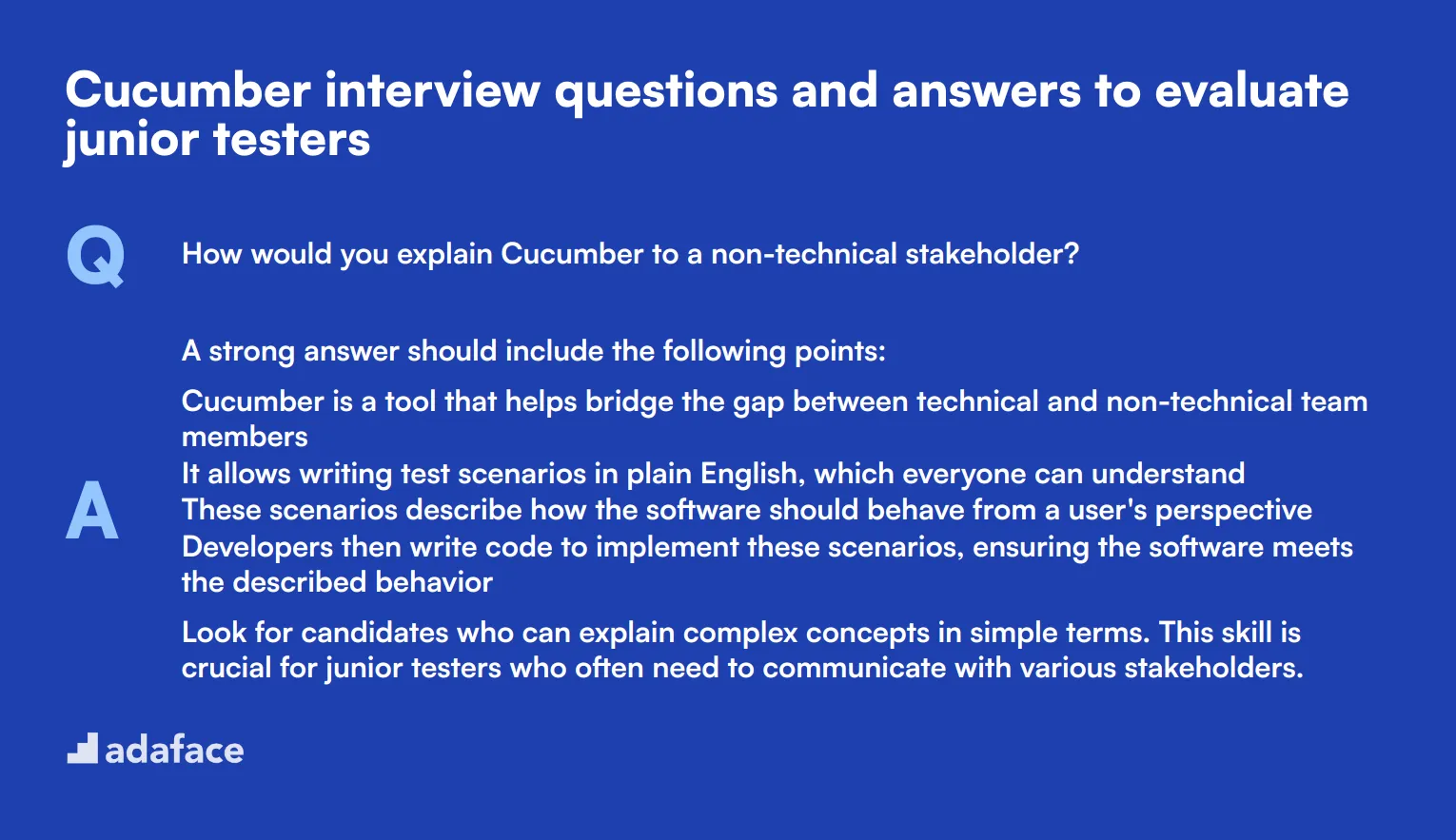
When evaluating junior testers for Cucumber proficiency, it's crucial to ask questions that assess their practical understanding and problem-solving skills. These 8 carefully crafted questions will help you gauge a candidate's grasp of Cucumber basics and their ability to apply this knowledge in real-world testing scenarios. Use them to identify candidates who can hit the ground running in your Cucumber-based testing projects.
1. How would you explain Cucumber to a non-technical stakeholder?
A strong answer should include the following points:
- Cucumber is a tool that helps bridge the gap between technical and non-technical team members
- It allows writing test scenarios in plain English, which everyone can understand
- These scenarios describe how the software should behave from a user's perspective
- Developers then write code to implement these scenarios, ensuring the software meets the described behavior
Look for candidates who can explain complex concepts in simple terms. This skill is crucial for junior testers who often need to communicate with various stakeholders.
2. What's the difference between a Step and a Scenario in Cucumber?
An ideal answer should cover:
- A Step is a single action or verification in a test, like 'Given I am on the homepage'
- A Scenario is a complete user story or test case, composed of multiple Steps
- Steps are reusable across different Scenarios, while Scenarios are unique to a specific feature
- Steps are implemented in code, while Scenarios are written in Gherkin syntax
Candidates who can clearly differentiate between these concepts demonstrate a good understanding of Cucumber's structure and how to organize tests effectively.
3. How would you handle test data in Cucumber scenarios?
A comprehensive answer might include:
- Using Scenario Outlines with Examples tables for data-driven testing
- Storing test data in external files (CSV, JSON, etc.) and reading them in Step Definitions
- Using Cucumber's built-in data tables for small datasets within the feature file
- Implementing hooks to set up and tear down test data before and after scenarios
Look for candidates who can discuss multiple approaches and understand the pros and cons of each method. This shows adaptability and a deeper understanding of test data management.
4. How would you approach debugging a failing Cucumber scenario?
A strong answer should outline a systematic approach:
- Review the error message and stack trace
- Check the scenario steps and corresponding step definitions
- Use debugging tools or add print statements to track variable values
- Isolate the issue by running individual steps or scenarios
- Verify test data and environment setup
- Review recent code changes that might have affected the scenario
Candidates who demonstrate a methodical debugging process show problem-solving skills essential for effective testing.
5. How can you improve the readability of Cucumber scenarios?
Look for answers that include:
- Using clear and concise language in scenario descriptions
- Avoiding technical jargon in feature files
- Utilizing Background for common setup steps
- Keeping scenarios focused on a single behavior or functionality
- Using descriptive step definitions that match natural language
- Organizing features and scenarios in a logical structure
Candidates who emphasize readability understand the importance of clear communication in BDD and can create tests that serve as living documentation.
6. How would you handle waiting for asynchronous operations in Cucumber tests?
A good answer should cover:
- Implementing explicit waits in step definitions
- Using custom timeout settings for specific operations
- Leveraging Cucumber's built-in hooks for setup and teardown
- Implementing retry mechanisms for flaky tests
- Avoiding hard-coded sleeps and preferring conditional waits
This question assesses the candidate's understanding of real-world testing challenges and their ability to create robust, reliable tests.
7. How would you organize and maintain a large suite of Cucumber tests?
An effective answer might include:
- Grouping related features and scenarios into logical directories
- Using tags to categorize and selectively run tests
- Implementing a consistent naming convention for features and step definitions
- Utilizing a Page Object Model for web application testing
- Regular refactoring to remove duplicate code and improve maintainability
- Version controlling test scripts alongside application code
Look for candidates who understand the importance of scalability and maintainability in test automation.
8. How would you integrate Cucumber tests into a continuous integration pipeline?
A comprehensive answer should cover:
- Configuring the CI tool (e.g., Jenkins, GitLab CI) to run Cucumber tests
- Setting up appropriate test environments for different stages (dev, staging, prod)
- Generating and publishing test reports after each run
- Implementing parallel test execution for faster feedback
- Setting up notifications for test failures
- Integrating with other tools like JIRA for issue tracking
This question assesses the candidate's understanding of DevOps practices and how Cucumber fits into the broader development workflow.
10 Cucumber questions related to automation processes
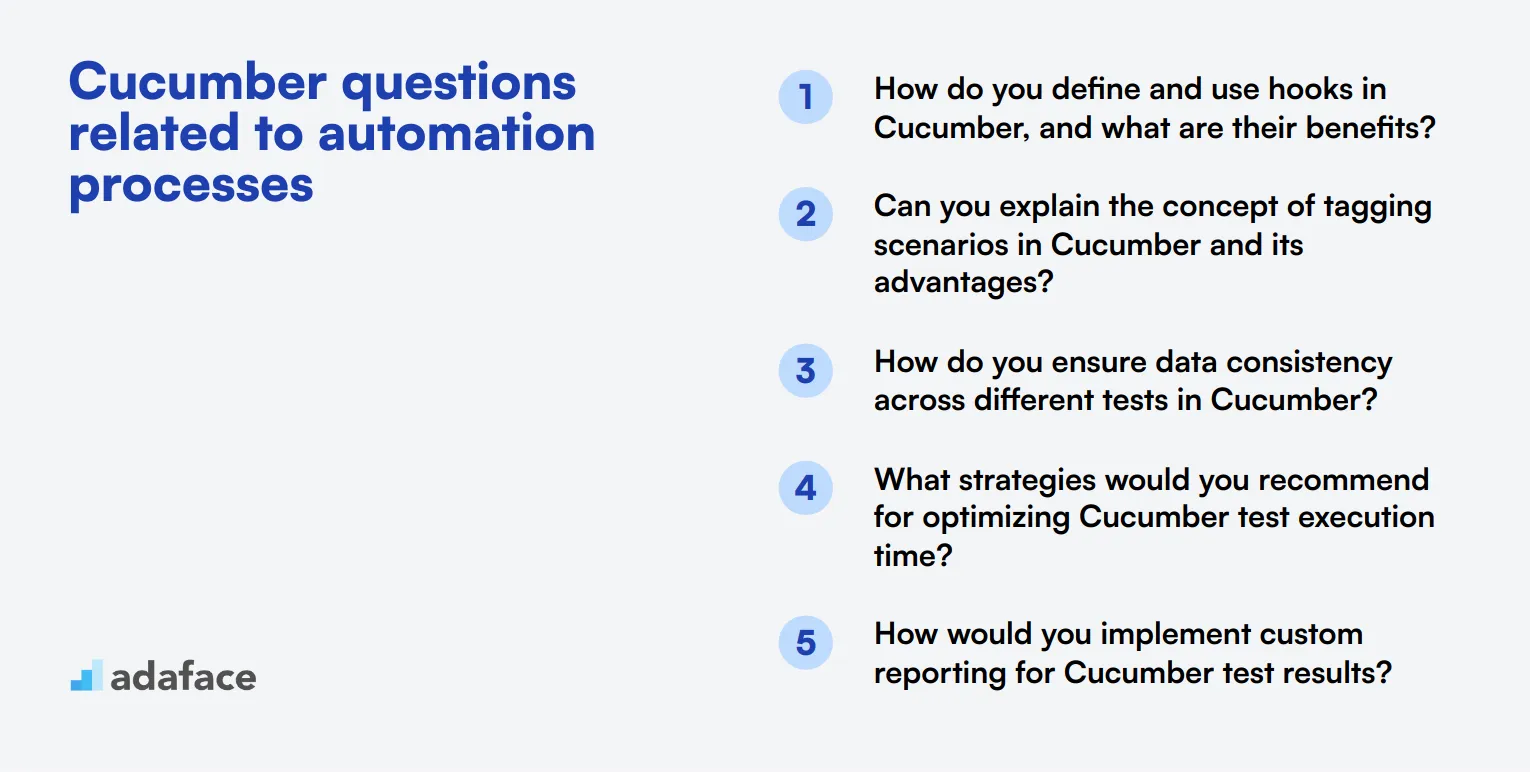
To assess candidates' understanding of automation processes in Cucumber, consider using this questions list. These questions will help you evaluate their technical skills and practical experience relevant to your team's needs, especially when hiring for roles like a test engineer.
- How do you define and use hooks in Cucumber, and what are their benefits?
- Can you explain the concept of tagging scenarios in Cucumber and its advantages?
- How do you ensure data consistency across different tests in Cucumber?
- What strategies would you recommend for optimizing Cucumber test execution time?
- How would you implement custom reporting for Cucumber test results?
- Can you describe the role of the cucumber.yml file in a Cucumber project?
- What tools or frameworks would you integrate with Cucumber for better performance?
- How can Cucumber support collaboration between technical and non-technical team members?
- What methods do you use to keep your step definitions DRY (Don't Repeat Yourself)?
- How do you handle version control for your Cucumber test cases?
9 Cucumber interview questions and answers related to BDD practices
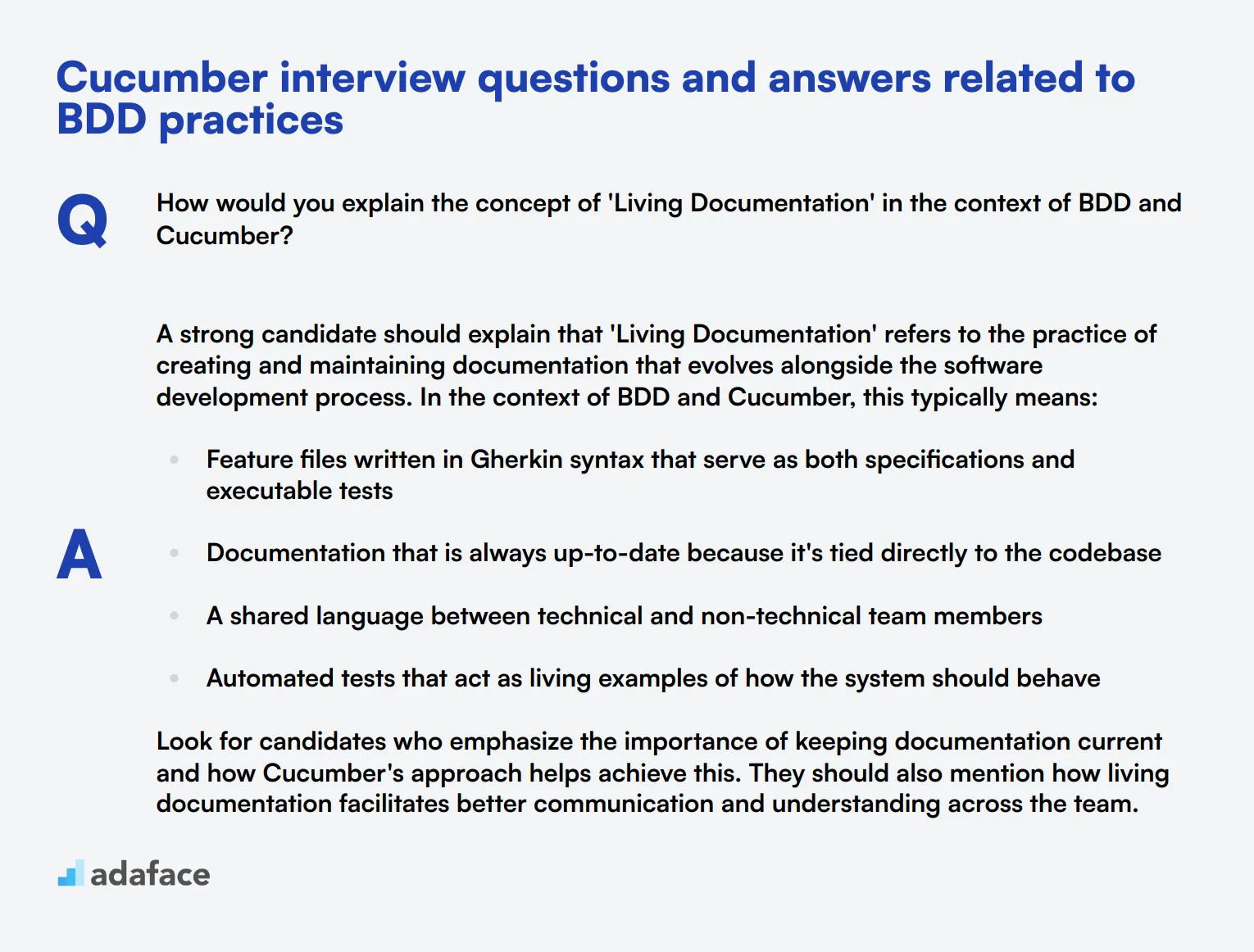
Ready to dive into the world of Behavior-Driven Development with Cucumber? These 9 interview questions will help you gauge a candidate's understanding of BDD practices and their ability to implement them effectively. Use these questions to spark insightful discussions and uncover how well applicants can bridge the gap between technical and non-technical stakeholders in the software development process.
1. How would you explain the concept of 'Living Documentation' in the context of BDD and Cucumber?
A strong candidate should explain that 'Living Documentation' refers to the practice of creating and maintaining documentation that evolves alongside the software development process. In the context of BDD and Cucumber, this typically means:
- Feature files written in Gherkin syntax that serve as both specifications and executable tests
- Documentation that is always up-to-date because it's tied directly to the codebase
- A shared language between technical and non-technical team members
- Automated tests that act as living examples of how the system should behave
Look for candidates who emphasize the importance of keeping documentation current and how Cucumber's approach helps achieve this. They should also mention how living documentation facilitates better communication and understanding across the team.
2. Can you describe a situation where you had to refactor Cucumber scenarios to improve maintainability?
An ideal response should include a specific example from the candidate's experience. They might describe scenarios such as:
- Reducing duplication by creating reusable step definitions
- Simplifying complex scenarios by breaking them down into smaller, more focused ones
- Improving readability by refining the language used in feature files
- Introducing scenario outlines to handle multiple test cases more efficiently
Pay attention to how the candidate balances technical improvements with maintaining clarity for non-technical stakeholders. A strong answer will demonstrate their ability to think critically about test design and their understanding of BDD principles.
3. How do you ensure that your Cucumber scenarios are providing value to the business and not just testing implementation details?
A good answer should emphasize the importance of focusing on business outcomes and user behavior rather than technical implementation. Candidates might mention:
- Collaborating closely with product owners and business analysts to understand key features and user stories
- Writing scenarios from the user's perspective, focusing on what the user does and expects
- Avoiding technical jargon in feature files and using business language instead
- Regularly reviewing scenarios with stakeholders to ensure they align with business goals
Look for candidates who understand that Cucumber is not just a testing tool, but a means of communication between technical and non-technical team members. They should demonstrate an ability to translate business requirements into clear, actionable scenarios.
4. How would you handle a situation where the business stakeholders are resistant to adopting BDD and Cucumber?
A strong candidate should demonstrate empathy and problem-solving skills in their response. They might suggest approaches such as:
- Educating stakeholders on the benefits of BDD, including improved communication and reduced misunderstandings
- Starting small with a pilot project to showcase the value of Cucumber in action
- Involving stakeholders in the process of writing scenarios to give them ownership
- Demonstrating how Cucumber can serve as living documentation, reducing the need for separate specification documents
Look for candidates who emphasize the importance of patience and persistence in driving change. They should also show an understanding of the challenges stakeholders might face and be able to address concerns proactively.
5. How do you balance the need for detailed scenarios with keeping them concise and readable?
An effective answer should demonstrate the candidate's ability to write clear, focused scenarios. They might mention strategies like:
- Using the Given-When-Then format to structure scenarios clearly
- Focusing on one specific behavior or outcome per scenario
- Utilizing scenario outlines for similar test cases with different data
- Leveraging background steps for common preconditions
- Creating reusable step definitions for common actions
Look for candidates who understand the importance of readability and maintainability in BDD scenarios. They should be able to explain how they decide what level of detail is appropriate and how they keep scenarios focused on business value rather than getting lost in technical minutiae.
6. How do you approach writing scenarios for complex business rules or workflows?
A strong response should demonstrate the candidate's ability to break down complex problems into manageable pieces. They might describe approaches such as:
- Collaborating closely with domain experts to understand the full complexity of the rules
- Using scenario outlines to test multiple variations of a complex rule
- Breaking down complex workflows into smaller, focused scenarios
- Utilizing Cucumber's background feature to set up complex preconditions
- Creating clear, descriptive step definitions that encapsulate complex logic
Pay attention to how the candidate balances the need for comprehensive testing with maintaining clarity and readability in their scenarios. Look for evidence of their ability to translate complex business logic into understandable Gherkin syntax.
7. How do you ensure that your Cucumber tests remain valuable as the system evolves over time?
An ideal answer should address the challenge of maintaining test suites as software changes. Candidates might mention strategies such as:
- Regularly reviewing and updating scenarios with stakeholders to ensure they still reflect current business needs
- Refactoring scenarios and step definitions as the system changes to prevent test rot
- Using tags to organize and manage large numbers of scenarios
- Implementing a robust CI/CD pipeline to catch breaking changes early
- Encouraging developers to update relevant scenarios when implementing new features or changes
Look for candidates who understand that maintaining Cucumber tests is an ongoing process. They should demonstrate an awareness of the importance of keeping tests aligned with current business requirements and system behavior.
8. How do you handle flaky or inconsistent Cucumber tests in your CI/CD pipeline?
A good answer should demonstrate the candidate's troubleshooting skills and understanding of test reliability. They might suggest approaches such as:
- Identifying and isolating flaky tests using tags or other metadata
- Implementing retry mechanisms for tests that fail intermittently
- Improving test environment stability and consistency
- Refactoring tests to remove dependencies on external services or timing issues
- Implementing logging and monitoring to help diagnose the root causes of flakiness
Look for candidates who recognize that flaky tests can undermine confidence in the test suite and slow down development. They should be able to discuss strategies for both addressing existing flaky tests and preventing new ones from being introduced.
9. How do you promote a BDD mindset across different teams in an organization?
An effective answer should showcase the candidate's ability to drive cultural change and collaborate across teams. They might suggest strategies like:
- Organizing workshops and training sessions to introduce BDD concepts and Cucumber usage
- Encouraging cross-functional collaboration in writing and reviewing scenarios
- Sharing success stories and metrics demonstrating the benefits of BDD
- Creating a community of practice for BDD enthusiasts across the organization
- Integrating BDD practices into the software development lifecycle and project kickoff processes
Look for candidates who understand that adopting BDD is as much about changing mindsets as it is about implementing tools. They should demonstrate an ability to communicate the value of BDD to different stakeholders and to lead by example in applying BDD principles.
Which Cucumber skills should you evaluate during the interview phase?
Conducting a single interview can never fully encompass a candidate's complete range of skills. However, when it comes to Cucumber, there are key areas that are essential to evaluate. These core skills will help you determine if the candidate possesses the necessary competencies to succeed in your team.
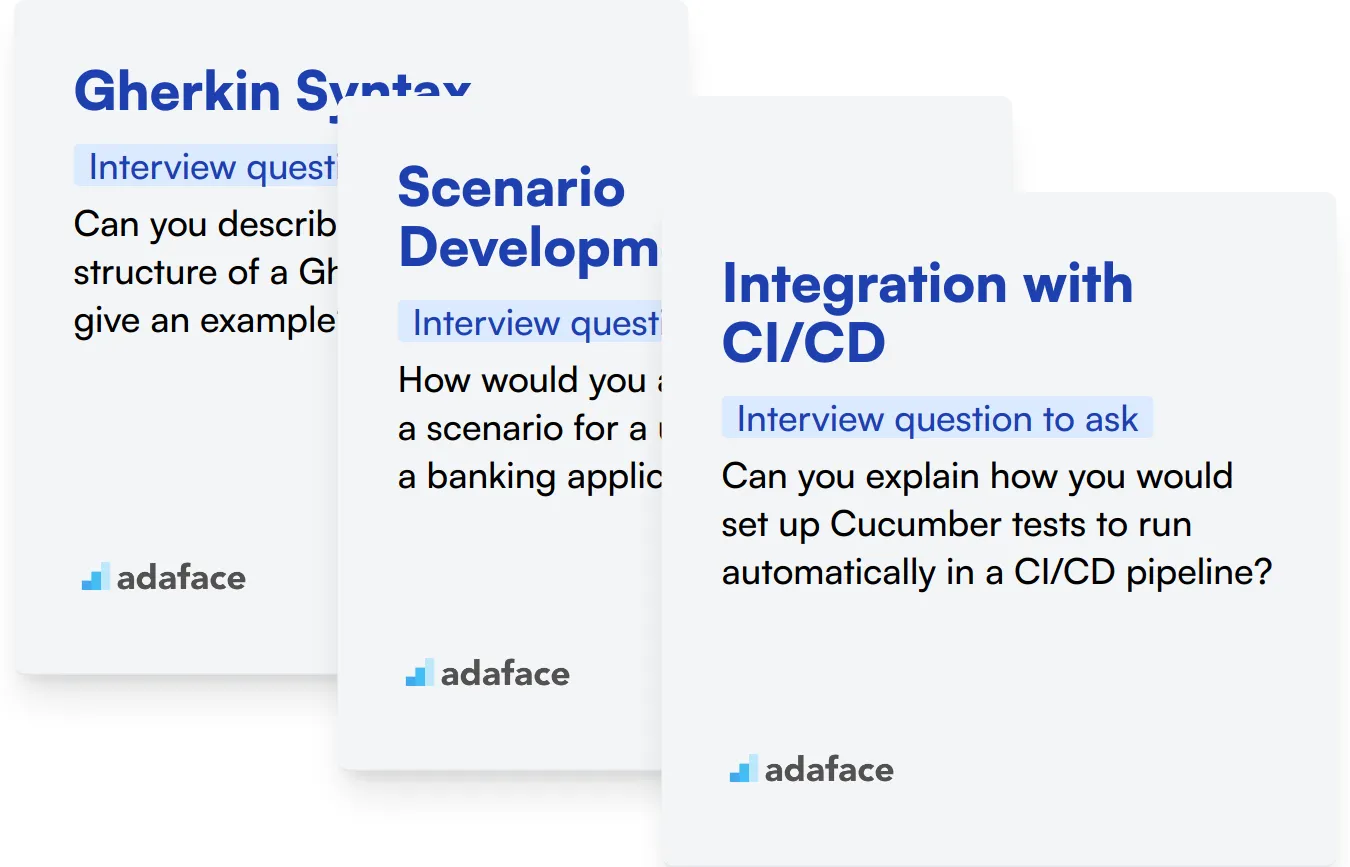
Gherkin Syntax
Understanding Gherkin syntax is fundamental for anyone working with Cucumber. It allows for clear communication between non-technical stakeholders and developers.
You can use an assessment test with relevant MCQs to filter out candidates who have a solid understanding of Gherkin syntax. Check out our Cucumber Testing Online Test for this purpose.
Additionally, you can ask targeted interview questions to gauge the candidate's proficiency in Gherkin syntax.
Can you describe the basic structure of a Gherkin file and give an example?
Look for answers that include elements like Feature, Scenario, Given, When, and Then. The candidate should be able to provide a clear and concise example that demonstrates their understanding.
Scenario Development
Effective scenario development is crucial for creating meaningful test cases that reflect real-world use cases. This ensures comprehensive test coverage.
A well-designed assessment with MCQs can help you identify candidates who excel in scenario development. Use our Cucumber Testing Online Test to assess this skill.
You can also evaluate this skill by asking specific questions during the interview.
How would you approach writing a scenario for a user logging into a banking application?
Look for the candidate's ability to identify key actions and outcomes. They should mention steps like entering credentials, clicking the login button, and verifying access to the dashboard.
Integration with CI/CD
Integrating Cucumber tests with CI/CD pipelines is essential for automated testing and continuous delivery. This skill ensures that tests are run automatically, providing quick feedback.
Consider using an assessment to measure the candidate's knowledge of CI/CD integration with Cucumber. The DevOps Online Test can be useful for this purpose.
Ask targeted questions to further probe the candidate's experience with CI/CD integration.
Can you explain how you would set up Cucumber tests to run automatically in a CI/CD pipeline?
The candidate should describe steps such as configuring a CI/CD tool, setting up the environment, and integrating Cucumber tests. Look for specific tools and methods they have used in the past.
3 Tips for Effectively Using Cucumber Interview Questions
Before you start putting what you've learned about Cucumber interview questions to use, consider these essential tips to enhance your interview process.
1. Incorporate Skills Tests Before Interviews
Using skill tests before the interview helps to filter candidates based on their actual abilities rather than just their resumes. This approach provides objective data that can enhance your decision-making process.
Consider leveraging tests such as the Cucumber Testing Online Test or the QA Engineer Test to evaluate essential skills related to Cucumber. These tests focus on practical knowledge that candidates should possess.
By implementing skill tests early in the hiring process, you improve the quality of candidates entering your interviews, allowing you to allocate your time to more relevant discussions and decision-making.
2. Curate Targeted Interview Questions
With limited time during interviews, it’s important to select a focused set of questions that evaluate key competencies. This strategy maximizes the effectiveness of your interviews and helps assess candidates on critical fronts.
In addition to Cucumber-specific questions, consider integrating related technical and behavioral questions to assess a candidate's overall fit. For example, you might include questions from areas like Automation Testing or Quality Assurance.
This approach ensures that you cover a range of skills, including communication, culture fit, and technical proficiency, without overwhelming yourself or the candidate.
3. Ask Follow-Up Questions
Relying solely on initial interview questions may not provide a complete understanding of a candidate’s expertise. Follow-up questions are necessary to explore the depth of their knowledge and address potential gaps in their responses.
For instance, if a candidate answers a Cucumber question about writing Gherkin syntax, you could follow up with, 'Can you explain how you would handle complex scenarios in Gherkin?' This encourages candidates to elaborate and reveals their true understanding and approach to complexities.
Hire skilled Cucumber testers with the right interview questions and assessments
When hiring someone with Cucumber testing skills, it's important to accurately assess their abilities. The most effective way to do this is by using skill tests. Consider using our Cucumber Testing Online Test or QA Engineer Test to evaluate candidates' proficiency.
After using these tests to shortlist the best applicants, you can proceed with interviews. To streamline your hiring process and find the right candidates, explore our Online Assessment Platform for more comprehensive testing solutions tailored to your needs.
Cucumber Test
Download Cucumber interview questions template in multiple formats
Cucumber Interview Questions FAQs
Cucumber is a testing tool that supports Behavior Driven Development (BDD). It's used to write acceptance tests in a natural language format that both developers and non-technical stakeholders can understand.
Structure questions based on the candidate's experience level. For juniors, focus on basic concepts and syntax. For seniors, delve into advanced automation, BDD practices, and problem-solving scenarios.
Key areas include understanding of Gherkin syntax, feature file creation, step definition implementation, automation integration, BDD principles, and best practices in test scenario writing.
Ask candidates to write sample Gherkin scenarios, explain how they would implement step definitions, or discuss real-world challenges they've faced using Cucumber in previous projects.
Cucumber facilitates collaboration between technical and non-technical team members in Agile environments. It helps in creating living documentation and ensures that software meets business requirements through executable specifications.

40 min skill tests.
No trick questions.
Accurate shortlisting.
We make it easy for you to find the best candidates in your pipeline with a 40 min skills test.
Try for freeRelated posts
Free resources




